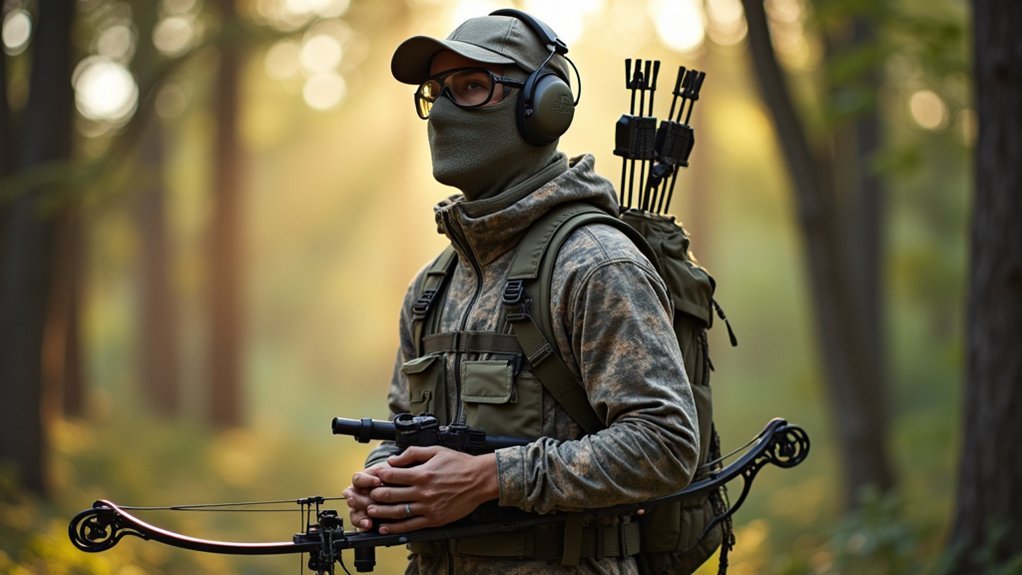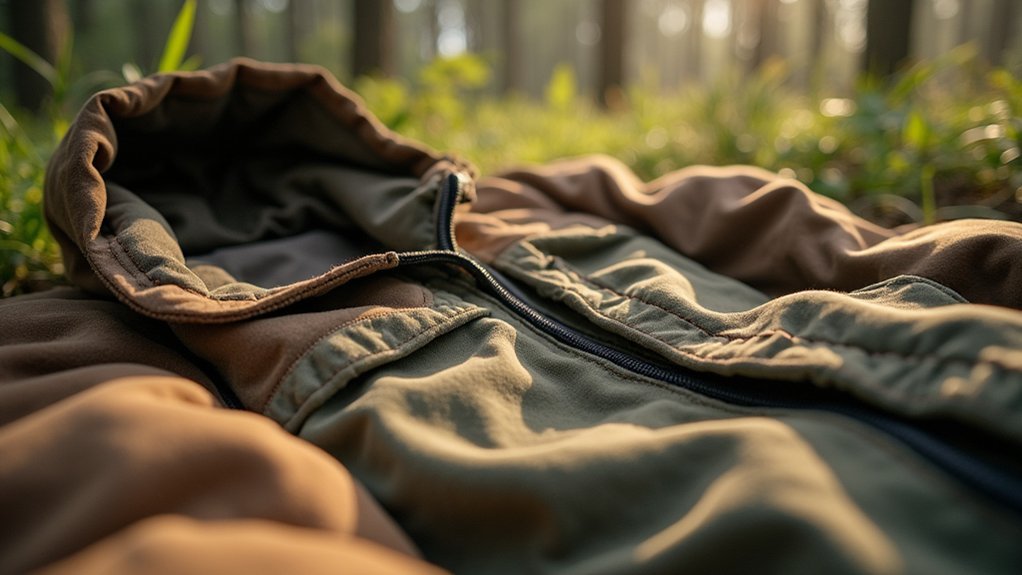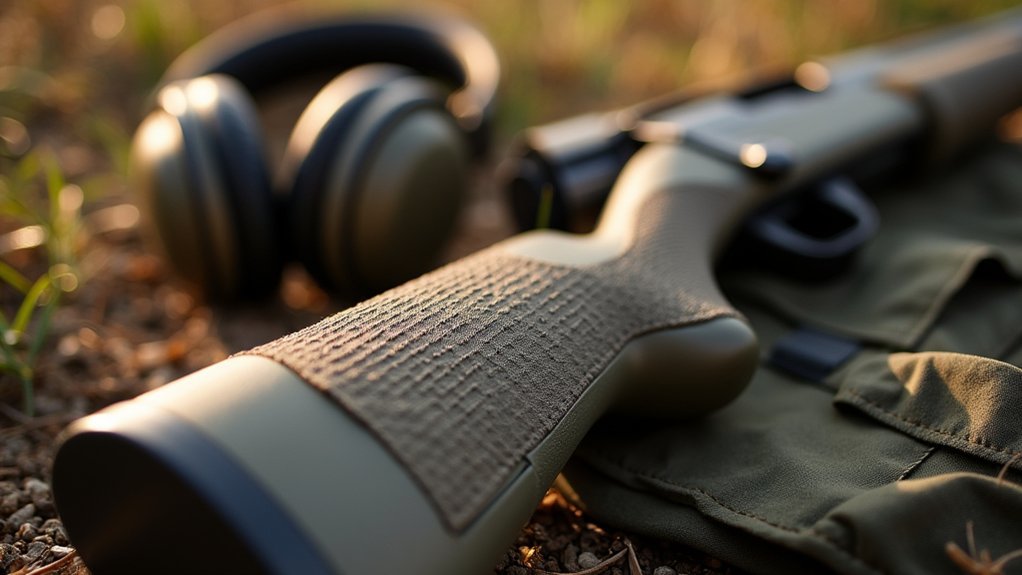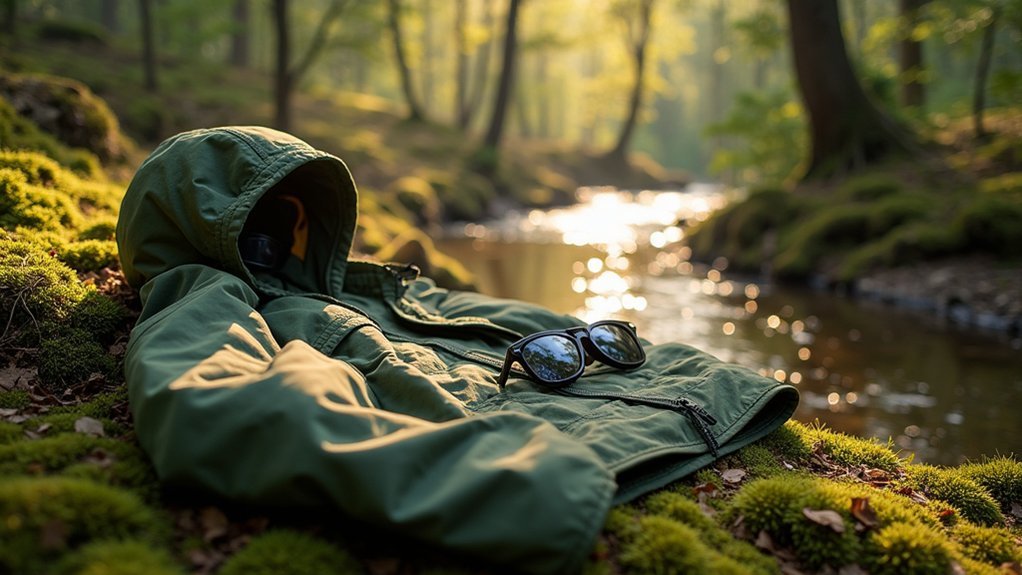Sensory-friendly hunting gear combines silent fabrics, pressure-regulating vests, and low-contrast camouflage to create peaceful outdoor experiences. You’ll benefit from brushed materials that eliminate rustling sounds, weighted vests (5-10% of body weight) for stability, and nature-inspired patterns that reduce visual fatigue. Look for moisture-wicking fabrics, temperature regulation features, and adjustable equipment that accommodates various physical abilities. These thoughtful gear choices can transform your hunting experience from potentially overwhelming to deeply rewarding.
The Science Behind Sensory-Responsive Hunting Apparel

While traditional hunting gear focused primarily on camouflage patterns, today’s sensory-responsive hunting apparel incorporates cutting-edge science to outsmart wildlife’s keen senses.
Modern technologies like Code of Silence’s S-18 patterns break up your outline, making you virtually invisible against natural backgrounds. The soft, flexible fabrics remain completely silent even in freezing temperatures, preventing auditory detection when movement is necessary.
Today’s S-18 patterns leverage advanced visual disruption to render hunters practically undetectable in woodland environments.
You’ll find innovations extending beyond visual camouflage. Neutral-LR™ technology minimizes light reflection, while HECS technology blocks your body’s electrical emissions that deer can detect. These multilevel approaches address whitetails’ remarkable sensory capabilities.
Your success depends on understanding deer’s sensory gating mechanisms—they prioritize movement detection over color recognition.
Selecting Weighted Vests and Jackets for Outdoor Stability
When selecting a weighted hunting vest or jacket, you’ll benefit from models that distribute weight evenly across your torso to prevent strain and maintain natural movement patterns.
Choose weights between 5-10% of your body weight as your starting point, gradually increasing as your strength and stability improve without compromising mobility.
For ideal outdoor stability, verify your weighted gear includes adjustable features that let you customize pressure based on terrain conditions and hunt duration. Consider vests with moisture-wicking materials to maintain comfort during extended hunting sessions in variable weather conditions.
Weight Distribution Benefits
Although often overlooked by hunters, proper weight distribution in your gear can greatly enhance your stability and endurance in the field. When your equipment’s weight is properly distributed, you’ll maintain a lower center of gravity, reducing back strain and improving breathing efficiency during long treks. Positioning heaviest items against your back creates a more balanced load that’s easier to transport over varied terrain.
| Benefit | Impact | Why It Matters |
|---|---|---|
| Hip-centered load | Reduces back strain | Prevents fatigue on multi-day hunts |
| Balanced weight | Maintains natural gait | Improves mobility in rough terrain |
| Strategic placement | Heavy items at hip height | Enhances stability and balance |
| Minimal shoulder weight | Reduces muscle tension | Allows for easier breathing |
| Even distribution | Prevents hotspots | Increases comfort during extended wear |
Your body will thank you for thoughtful weight distribution, allowing you to focus on the hunt rather than discomfort or fatigue.
Pressure Selection Guide
Building on proper weight distribution, the next consideration for hunters with sensory needs is selecting weighted vests and jackets that provide ideal pressure.
When choosing your sensory-friendly hunting gear, start with lighter weights (10-15 lbs) and gradually increase as your comfort level improves. Look for vests made with breathable, moisture-wicking fabrics like nylon and Lycra to manage sweat during long hunting sessions. Before increasing your vest weight, ensure you’ve properly built up your strength and endurance to prevent potential injuries during extended hunting trips.
- Select adjustable vests allowing for 5-10% of your body weight to start
- Choose designs with slim profiles to minimize movement interference while tracking
- Prioritize padded shoulder areas for extended comfort during day-long expeditions
- Opt for weather-resistant materials that maintain effectiveness in varying hunting conditions
Silent Fabrics: Minimizing Noise for Wildlife Approach

You’ll gain a significant edge in the field with brushed fabric technologies that eliminate the telltale rustling sounds that alert wildlife to your presence.
Today’s sound-dampening material innovations, including Carbon Alloy® technology and ultra-quiet fleece, offer both moisture-wicking capabilities and noise reduction in a single package.
The integration of specialized options like Berber-Wool™ and Fleece-Wool™ provides natural appearances with reduced light reflectance for enhanced concealment.
These advancements allow you to move without detection, whether you’re shifting position in your stand or stalking closer to your target.
Brushed Fabric Technologies
When hunters move through the wilderness, even the slightest rustle from their clothing can alert nearby wildlife.
Brushed tricot fabric has revolutionized hunting gear with its tri-layer construction specifically designed for noise suppression. You’ll find this technology integrated into stealth packs and specialized hunting apparel that keep you silent as you stalk your prey. Many premium hunting jackets feature bonded ultra-soft fleece that enhances quietness while providing essential warmth during long waits in the field.
- Tri-layer silent fabric minimizes sound during movement while maintaining breathability
- Rubberized components replace noisy Velcro and metal hardware for complete silence
- Silent-closing zippers prevent the telltale sounds that often spook wildlife
- Moisture-wicking properties keep fabric dry, eliminating the noise of rustling wet clothing
This specialized fabric technology works harmoniously with camouflage patterns, making it effective across various terrains and hunting conditions from dense forests to open fields.
Sound-Dampening Material Innovations
Beyond brushed fabrics, the hunting industry has embraced a remarkable range of sound-dampening materials that transform the stealthy hunter’s experience. You’ll find everything from mass loaded vinyl to specialized rubber coatings that minimize gear noise. Eliminating high-pitch noises from your gear can be the difference between a successful hunt and going home empty-handed.
| Material | Application |
|---|---|
| Mass Loaded Vinyl | Reflects sound; pairs well with plywood barriers |
| Acoustical Caulk | Maintains flexibility to seal gaps after drying |
| Neoprene Grips | Silences metal components like cam buckles |
| Hockey Tape | Reduces metal-to-metal contact on climbing sticks |
| Stealth Strips | Quiets carabiners and other metal attachments |
For maximum stealth, consider applying bicycle inner tubing to buckles or heat shrink tubing to metal components. These lightweight solutions won’t add significant weight to your pack but will dramatically reduce equipment noise when approaching wildlife.
Movement Without Detection
The silent approach to wildlife requires exceptional fabric technologies that virtually eliminate detection.
You’ll find that natural fibers like wool and engineered materials such as SilentX work together to keep you undetected during critical hunting moments. The brushed fleece in Proximity Technology offers body-mapped silence when you’re closing in on game. Our premium Quiet Tech Jacket and matching pants combine performance with affordability at just $109.99 each.
- Friction-reducing designs prevent the telltale “swish” when your arms or legs move through vegetation.
- Softshell materials balance stealth with weather protection for versatile hunting conditions.
- Strategically placed silent fabrics prioritize noise reduction in high-movement areas.
- Layering systems engineered for silent interaction between garments during stalking.
These innovations shine particularly in cold weather hunts where sound travels further and in dense vegetation where fabric noise can instantly alert prey.
Customizing Grip Features for Comfort and Control

Customizing your hunting gear’s grip features can greatly enhance both comfort and control during extended trips in the field.
Materials like cork, EVA, and synthetics offer varying levels of moisture resistance and texture, keeping your hands secure in all conditions.
Consider ergonomic designs that match your hand’s natural contours.
Adjustable grips like the HDA Pro Grip II and III let you fine-tune angles to match your shooting style, while width options (3/4″ or 5/8″) accommodate different hand sizes.
For DIY customization, tools like the CRB PRO Inletting tool help create precise fits.
Adding reference points guarantees consistent positioning, reducing fatigue and improving accuracy.
The right grip customization not only personalizes your equipment but markedly enhances performance when every movement counts.
Installing texture enhancers like tennis racket tape provides additional grip security while maintaining a slim profile.
Natural Camouflage Patterns That Reduce Visual Stress
Natural camouflage patterns inspired by biomimetic design principles don’t just hide you from prey—they’ll actually reduce your visual fatigue during long hunting sessions.
Low-contrast camo patterns with organic shapes and textures minimize eye strain by eliminating the harsh lines and reflective surfaces that force your eyes to constantly readjust. The incorporation of soft-edged photographic images of natural elements creates patterns that are both effective for concealment and easier on the hunter’s eyes.
You’ll experience greater comfort and enhanced endurance with nature-inspired color harmonies that seamlessly blend earth tones to create a visually calming effect in your peripheral vision.
Biomimetic Design Benefits
While traditional hunting gear serves its basic purpose, biomimetic camouflage patterns revolutionize how hunters blend with their surroundings by reducing visual stress for both the hunter and prey.
By mimicking natural elements and integrating scientific principles of visual deception, these designs create a more immersive hunting experience.
You’ll find biomimetic designs offer advantages beyond mere concealment:
- Create 3D visual effects that maintain effectiveness regardless of viewing distance or angle
- Adapt to changing environments and seasons, ensuring year-round camouflage effectiveness
- Reduce your anxiety and improve focus by providing a genuine sense of environmental integration
- Incorporate advanced materials that optimize both visual deception and physical comfort
This scientifically-advanced approach to camouflage not only enhances your stealth but also deepens your connection to the natural world during your hunting experience.
Understanding the difference between how humans and animals perceive colors is essential when selecting gear, as animal vision significantly impacts the effectiveness of even the most advanced camouflage patterns.
Low-Contrast Camo Patterns
Low-contrast camo patterns have revolutionized hunting gear by addressing a fundamental challenge that traditional camouflage often overlooks—visual stress reduction.
These patterns integrate seamlessly with natural surroundings, using muted tones and balanced colors that don’t create jarring visual disruptions in the environment.
You’ll find these designs particularly effective in dense forests, wetlands, and mountainous terrain where they mimic local textures like tree bark and foliage. When hunting in lush green environments, it’s important to consider that vegetation with high chlorophyll content naturally reflects more infrared light.
The patterns work by absorbing light naturally rather than reflecting it, making you less detectable to game animals with keen eyesight.
When you’re stationary, these patterns help maintain your concealment, but they’re especially valuable during slow movements while stalking.
Nature-Inspired Color Harmony
Unlike traditional high-contrast designs, nature-inspired color harmony in hunting gear mimics the subtle color gradients found in wilderness environments.
You’ll find that earthy tones like tan, brown, and gray create a seamless blend with your surroundings, reducing visual stress while maintaining effective concealment.
When selecting nature-inspired camo, consider these stress-reducing elements:
- Leaf and bark patterns that enhance depth perception in forests and marshes
- Greenleaf designs ideal for late spring and early fall hunts
- Regionally-specialized patterns engineered for specific terrains like woodlands or prairies
- Seasonally-adaptive color palettes that change with natural environments
This harmonious approach to camouflage not only improves your concealment but creates a more peaceful hunting experience by aligning you visually with nature’s own design language. Mossy Oak patterns have been proven effective through decades of field testing by millions of loyal hunters.
Adaptive Technologies That Enhance the Forest Experience
As technology continues to evolve, modern hunters benefit from an array of sophisticated adaptive gear that greatly enhances their forest experience while minimizing environmental disruption.
You’ll find electromagnetic signature blocking materials like HECS camouflage that mask your body’s electrical emissions, preventing wildlife from sensing your presence through fields they naturally detect.
Smart apparel now integrates multi-sensory features—scent control technology, temperature regulation, and tactile mimicry of natural textures.
Your hunting experience improves further with precision optics that reduce unnecessary movement and ergonomic firearms with improved AR 15 triggers for controlled shots.
Digital camouflage patterns confuse animal visual processing while three-dimensional designs break up your human outline.
These innovations work together, creating a harmonious hunting experience that respects the forest’s delicate sensory ecosystem. Field testing has demonstrated that HECS technology allows hunters to get up to 70% closer to game animals under favorable conditions.
Breathable Materials for Temperature Regulation

Maintaining ideal body temperature while hunting demands specialized breathable materials that work with your body’s natural processes. Your choice of fabrics directly impacts comfort and performance in the field, with options like merino wool offering superior moisture-wicking and temperature regulation for base layers.
When selecting hunting gear, consider these temperature-regulating features:
- Layering systems that combine moisture-managing base layers with insulating mid-layers for best thermal balance
- Ventilation features strategically placed to release excess heat during active periods without compromising warmth
- Ceramic prints like Badlands’ Heatwave that reflect body heat back to you in cold conditions
- Antimicrobial treatments that prevent odor buildup while maintaining breathability for extended hunts
DuraSpun Merino stands out for its unique construction with a single Cordura® thread that enhances durability while maintaining the softness hunters need for all-day comfort.
Multi-Sensory Considerations in Gear Selection
Selecting hunting gear requires a holistic approach that addresses all five senses, not just comfort or performance. Your choice of equipment affects both your sensory experience and your hunting success.
Consider camo patterns that match your environment to reduce visual stimulation while treating fabrics to minimize UV reflection. Choose noise-reducing materials that won’t rustle during movement, and incorporate silent communication devices to maintain stealth.
Don’t overlook scent management—use odor-resistant materials and scent-free detergents to avoid alerting wildlife or triggering sensitivity.
For tactile comfort, select non-irritating fabrics with moisture-wicking properties and ergonomic designs. Always carry a sensory kit containing essential oils, preferred snacks, and tactile items to help manage potential sensory challenges in the field.
Remember to pack sensory kits with stress-relief items and plan regular breaks to prevent sensory overload. This all-encompassing approach guarantees your gear supports both your sensory needs and hunting objectives.
Accessible Hunting Tools for Various Physical Abilities

Physical abilities should never limit anyone’s hunting experience, and today’s adaptive equipment makes the outdoors more accessible than ever before.
Modern innovations offer solutions for various mobility and sensory challenges, enabling independence and enjoyment in the field.
You’ll find equipment designed to accommodate specific needs while maintaining accuracy and comfort:
- Adaptive shooting rests from Be Adaptive Equipment support rifles, shotguns, pistols, and bows for those with limited mobility.
- Digital Crosshairs 1000A projects scope views onto LCD displays, benefiting hunters with visual challenges.
- Mouth-operated devices provide full control for individuals without arm or hand function.
- Modified vehicles with high-backed seats and 4-point harnesses allow quadriplegics to drive independently on hunting excursions.
The Primos Trigger Sticks provide stable shooting platforms that can be quickly adjusted for hunters with mobility issues.
These customizable solutions guarantee that hunting remains an inclusive activity regardless of physical limitations.
Building a Sensory-Supportive Hunting Community
While hunting traditions have deep roots in our culture, they haven’t always embraced participants with sensory processing challenges. You can change this by fostering partnerships with local hunting clubs and disability advocacy groups to create more inclusive experiences.
Start by organizing pre-hunting simulations where newcomers can practice in controlled environments. Train your volunteers to recognize and respond to sensory overwhelm, and designate quiet zones where hunters can retreat when needed. Consider establishing a code word system that allows participants to communicate when they need to take a break without drawing attention to themselves.
Consider implementing a buddy system pairing experienced hunters with those who’ve sensory sensitivities. Gather feedback after each event to continuously improve your accommodations.
Frequently Asked Questions
How Do I Wash Sensory-Friendly Hunting Clothes Without Damaging Special Fabrics?
You’ll need to wash your sensory-friendly hunting clothes using cold water, gentle cycles, and scent-free detergents. Always air dry or use low heat, and avoid fabric softeners that can damage special fabrics.
Can Sensory-Friendly Hunting Gear Be Used for Fishing or Hiking?
Yes, you’ll find sensory-friendly hunting gear works great for fishing and hiking too. The quiet fabrics, comfortable design, and distraction-reducing features transfer well to these activities, enhancing your overall outdoor experience.
What Age Can Children Start Using Sensory-Adaptive Hunting Equipment?
You can introduce children to sensory-adaptive hunting equipment around 8-10 years old with supervision, but they shouldn’t hunt independently until 12+ years when legally permitted in most jurisdictions.
How Do Weighted Hunting Vests Affect Shot Accuracy?
Weighted hunting vests can initially disrupt your accuracy as you adapt to the altered center of gravity. However, they’ll often improve your stability over time, resulting in steadier aim and potentially more accurate shots.
Are There Rental Options for Expensive Sensory-Friendly Hunting Technology?
Rental options for expensive sensory-friendly hunting tech are limited. You’ll rarely find specialized equipment at standard rental shops. Consider checking with adaptive sports organizations or hunting clubs that might share resources.
In Summary
When you’re outfitted with sensory-friendly gear, you’ll experience hunting in a more peaceful, focused way. You’re not just chasing game; you’re creating a mindful outdoor experience that accommodates your unique sensory needs. Remember, it’s about finding equipment that works with your body, not against it. Join the growing community of hunters who’ve discovered that comfort and accessibility don’t compromise effectiveness—they enhance it.





Leave a Reply